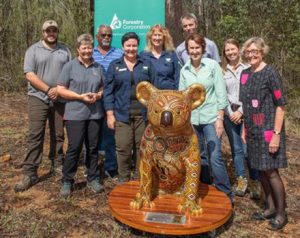
Forestry Corporation NSW employees with representatives from Bunya Land Council, NSW Government, Hello Koalas and Port Macquarie Koala Hospital.
The Cowarra state forest will soon be home to a new tourism precinct that will provide better access to existing attractions and cater for new events. The precinct will be funded by the NSW Government’s Regional Growth – Environment and Tourism Fund, together with a financial contribution from the Forestry Corporation of New South Wales and is expected to boost tourism in the local region. Source: Timberbiz
The organisers of the project said that: “Sustainable forest management is more important than ever as we rebuild fire affected towns with sustainably-managed timber for bridges, electricity poles and homes.
“This new precinct is no different and include local hardwood timber features throughout. In terms of wildlife recovery, discussions with Port Macquarie Koala Hospital have already been held with koala rehabilitation on site in mind.
“As well as opening up new opportunities, the precinct will become a nature-based rest stop for travellers on the legendary pacific coast drive and help showcase the world leading forest management techniques being used in the Cowarra State Forest.”
Forestry Corporation plans to model their approach to developing nature-based tourism in Cowarra state forest to that achieved at their tourism award-winning Sealy lookout (Niigi Niigi) in Orara East State Forest on the north coast.
The project will deliver the infrastructure needed to create the nature-based tourism precinct, including sealed road access, water and electricity connections, car parking and perimeter fencing.
In addition, providing access to the precinct will open up opportunities for new nature-based tourism attractions, such as tree-top adventure climbs, trail running, mountain bike riding, adventurethons and pop up cafes.
Forestry Corporation of NSW also hopes to work with traditional owners the Bunyah community, and with their permission, share their cultural practices and stories.
There is also potential for local aboriginal cultural heritage to be acknowledged and honoured within the precinct is exciting.
Plans for the site include forest and wildlife recovery education, information signage and use of sustainably sourced timber in infrastructure works.





